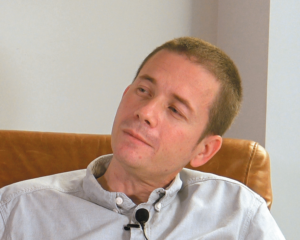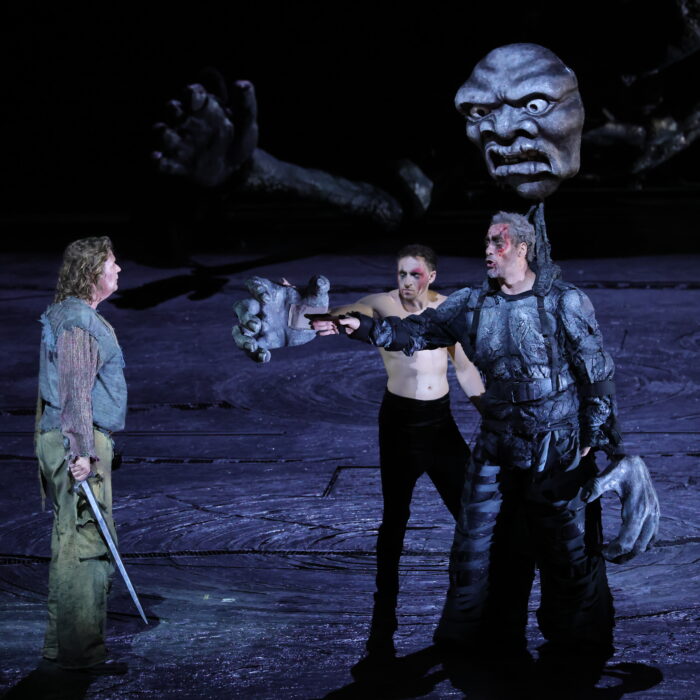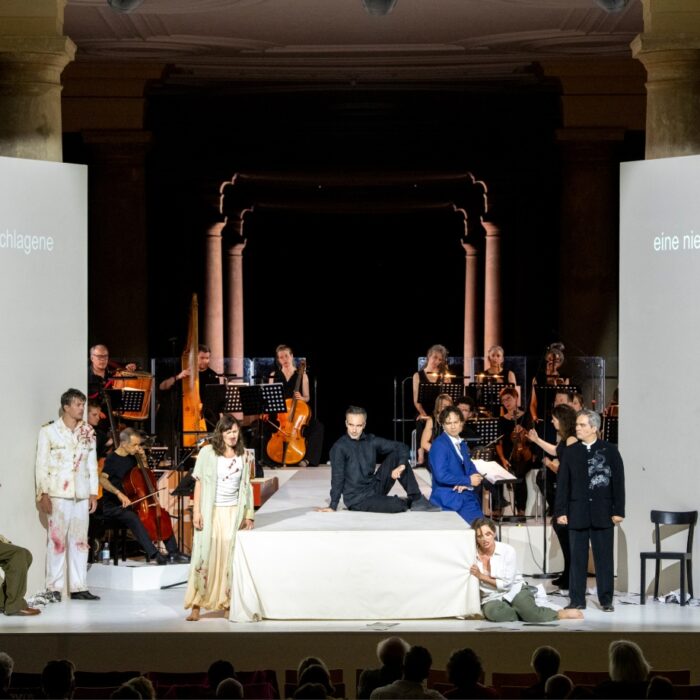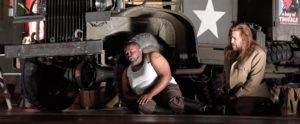
Deutsche Oper Berlin 2019-20 Review: La Forza del Destino
Despite Audience Indignation, Frank Castorf’s Unique Vision Enhances Verdi’s Bleak Masterwork
By Dejan Vukosavljevic(Credit: Thomas Aurin)
This review is for performances on September 14 and September 18, 2019.
The Deutsche Oper in Berlin started its new 2019-2020 season with a rather courageous project – a new production of Giuseppe Verdi’s bleakest opera “La Forza Del Destino” directed by Frank Castorf.
When the new season was announced back in March this year, there were few people that could really foresee what would be happening on the stage of Deutsche Oper on the opening night of September 8, 2019. It would not be an understatement to say that “La Forza Del Destino” in Berlin stirred many emotions, shakened many deeply rooted beliefs and utterly led to audience rioting, the latter of which was provoked by an ongoing feeling that Castorf was taking on the role as Verdi’s Slayer. However, one might, through thorough analysis, potentially see him as a Verdi enhancer.
Verdi Enhancer
First off, Castorf changed the work’s original timeline, setting it during the Spanish Civil War and fascist Italy in the 20th century.
As the orchestra opens up with well-known overture, the curtain rose to reveal Aleksandar Denic’s revolving stage set, consisting of several elements, each fitting its own purpose during different acts: the front part of the church, the house of Marchese di Calatrava, a war hospital, and a truck as part of historical background.
During these instances, baritone Stephen Bronk, in the role of Marchese di Calatrava, entered the stage, climbed some stairs and started a silent monologue that materialized as surtitles on surtitles screens to the right and to the left of the auditorium. The text the Marchese silently uttered is the beginning of Curzio Malaparte’s story “The Basket of Oysters” from his novel “Kaputt.”
It reads: “I have one glass eye. Can you tell which one is that? My left eye? How can you tell? Maybe because it is the one that looks human?” As he uttered these words silently, Curra and Dona Leonora enter the stage, a live camera giving close ups of both while the Marchese finishes his silent speech and the overture ends.
As would later be proven, this silent speech was actually the prelude for the most painful part of the opera leading to a diabolical revelation. The opera continues unimpeded with the first Act ending on Don Alvaro accidentally killing Calatrava, which Castorf refers as “demon took care of that bullet.” However, the scene doesn’t end here with the Marchese standing up, surrounded by several men including Indio, and picking up on his original speech, this time resoundingly telling the monologue about – eyes. The live camera focuses on Donna Leonora, and her right eye as she looks through a magnifying glass. Several men in black bring a covered basket to the stage, but what is that? Curra takes something from it, which looks like an oyster: she tastes it. “Are these from Dalmatia?” she asks.
Marchese delivers his final blow, being dead but undead, looking quite scary as a live camera now focuses on his face – telling another excerpt from Curzio Malaparte‘s novel “Basket of Oysters,“ this time its horrific end: “Oh, you see something shiny and think these are shiny oysters? Indeed, this is a gift from my loyal Ustasha – 20 kilos of human’s eyes.” The live camera shifts to the interior of the basket, and to the horror of the spectator we see human eyes in oyster shells. It is through this that the Marchese di Calatrava seems to enhance his curse to his daughter, foretelling the transition from a young and lively eye to a dead one.
In the First Act we also see video outtakes of Sergei Eisenstein’s movie “Que viva Mexico!” being projected onto a large screen to the left. This work has been called his greatest unfinished work and his greatest pain – we see long line of prisoners crawling through a narrow path, while a priest makes the sign of a cross.
Two Stories At the Same Time
At this point it is very important to understand the staging structure of the opera and real motives of stage director: he presents a work that is unfolding as an ongoing large movie set, shifting between different video outtakes and live camera action close-ups, all being projected onto a large screen. The live video action is showing mainly the principals, but also background developments in the second and third Act. Historical context is very important as Verdi was very aware of the horrors of the war and composed the opera not to alleviate its pains, but to emphasize them.
At the start of the second Act, the whole stage was filled with this sense of impending doom, alongside the appearance of Indio, a Brazilian dancer who could be interpreted as a projection of Leonora’s tormented soul. But as would be disclosed later, he played a bigger symbolic role.
The third act opened up with a big picture of Italian fascist dictator Benito Mussolini on the right side of the stage holding a camera, while the big screen showed the title “La Pelle.” It was an obvious reference to the famous work by Curzio Malaparte, as the action moves to Italy during World War II. A video sequence from the movie “La Pelle” (1981) was then displayed on the large screen, aligning with the spoken text on the stage. Don Alvaro enters and is questioned about being Christian. “Aren’t you ashamed of being a Christian,” he is asked. A video out-take from the movie shifts to the wood where we could see men nailed to the trunks of trees, with their arms outspread to form a cross. Night has fallen and there is much horror being felt. As Don Alvaro repeats that he is a Christian but that he did not do anything wrong and that he wanted to help, voices say: “Why do you want to help us? Because you are a Christian? Do you think that is a good reason? Aren’t the men who crucified us Christians like yourself?”
There is much to be said about this added text and video out-takes. Up to this moment (and later on, with additional text from “Skin”, Heiner Müller’s “Der Auftrag” and video out-takes from Malaparte’s movie “Il Cristo proibito”) Castorf seems to clash with religion, Christianity in particular. It aligns with Verdi’s own anti-clerical stance. Castorf here explores the idea of Verdi not following the religious path in his life, and that is a piece of a puzzle that every spectator needs to solve for himself: there is no uniform answer, no one solution that fits all. Castorf is here offering disseminated pieces that loosely connect together, but with a good reason: more gravity and original idea would be lost.
In the second part of the opera this ongoing composite theatrical-movie drama gyrates with more live camera close-up action of wounded soldiers in the War field hospital, while Indio performs his terrific dances in an almost delirious state. If there was an impression (during Leonora’s approach to the church and subsequent exchange with Fra Melitone and Padre Guardiano) that he was reflecting a tormented soul of Leonora, his presence among wounded soldiers in the War hospital adds new layer to his existence. Finally Indio reveals several complex, interacting dimensions of his character, by telling a fragment from Heiner Müller‘s “Der Auftrag”: “I am the Angel of Despair, my speech is silence, my singing the scream. With my hands I dissipate the intoxication, the numbness, the forgetting, the pleasure and torment of the bodies. My hope is the last breath. My hope is the first battle. I am the knife with the dead man opens his coffin. I will be the one. My flight is the uprising, my Heaven the abyss for tomorrow.” Adding finally: “This is the trip to Heaven for little money.”
Indio declares himself as an Angel of Despair, nicely aligning with bleak, morose, tragic character of Verdi’s work: there is nothing here to be happy about. Being in a form a of Brazilian Revuetänzer that further develops feelings and emotions of impending doom while giving the whole stage added dimensions of what will inevitably happen and cannot be avoided is an interesting idea.

(Credit: Thomas Aurin)
The Audience Strikes Back
While some might find many of these additions and concepts controversial, it wasn’t until the final act that the audience’s frustration really came to the fore. Baritone Marko Mimica in the role of Padre Guardiano and mezzosoprano Amber Fasquelle in the role of Curra, Donna Leonora’s maid, took on a dialogue in English – “The Dead God,” an excerpt from Curzio Malaparte’s “Skin.”
“What need is there for another Christ,” stated Mimica “Christ has saved the world already, once and for all.”
“Oh Jimmy, why don’t you understand that it isn’t necessary for a man to be Son of God, to rise again from the dead on the third day, and to sit on the right hand of the Father, in order to be Christ? It is those thousands and thousands of dead men who have saved the world, Jimmy,” responded Fasquelle.
It was at this moment that the first boos came to life.
“You attach too much importance to the dead. A man counts only if he is alive,” the dialogue continued.
“Here in Europe only dead count” – replied Fasquelle, who then had to contend with heated disdain from the audience. “Europe is a rubbish dump, a wretched, defeated continent. Come with us. America is a free country.
Audience members started to scream out “Viva Verdi” as the dialogue continued.
It is quite obvious that Frank Castorf did quite a lot of rehearsals with singers in delivering a speech text, but there is no way they could have anticipated such outbursts of disapproval thrown their way. Still they held their own amidst the environmental turmoil.
From Castorf’s perspective, the scene makes sense. If we take this scene into historical context, there is really much evidence that mid-19th century Europe was indeed wretched continent, that many people were oppressed and persecuted, that European harbors were full of people trying to flee to America, New Zealand and other overseas lands between 1850 and 1925. Again, if we take Castorf’s work as one huge puzzle waiting to be solved, then such an interpretation is certainly possible.
The opera continued with a video out-take from Malaparte’s movie “Il Cristo proibito” as a backdrop for the climactic battle between Alvaro and Carlo. The live camera then took over, showing how Leonora and her brother were united for a moment before he kills her.
But Castorf is not done yet with his vision for the work. Despite dying, Leonora rises. The final subversion, in the context of the entire production does have significance: paths still could be changed in the course of history.
Top Notch Music
A top notch cast was assembled for the new staging of La Forza Del Destino at Deutsche Oper Berlin, and there was really much to admire and to be happy about musically.
Spanish Maestro Jordi Bernàcer, Resident Conductor at the Opera of San Francisco, led vast musical forces in this new project. The performance from the pit was quite memorable, from the overture to the very end, with Bernàcer providing solid support to both musicians in the orchestra and singers on stage. Coordination between the pit and stage was in a good shape without grossly noticeable lapses.
The Deutsche Oper orchestra strings were in fine form, readily responding to Verdi’s richly pulsating music, and other instrumentation acted in full accord. The prelude to the third act was memorable with the solo clarinet offering rich sound and exquisite phrasing.
Lovers’ Doom
Uruguayan soprano Maria José Siri gave a very convincing account of Donna Leonora di Vargas. It would be an understatement to say that Siri literally stole first two acts. Siri portrayed Leonora as indecisive at the beginning but then overwhelmed by motions of dread and doom.
“Me pellegrina ed orfana” delivered her doubts over elopment with Don Alvaro and vocally matched the dramatic expressions. Completely utilizing the Deutsche Oper’s fantastic acoustics, Siri delivered the self-pitying aria with her full vocal potential, successfully shifting between fortissimo legato and blasting out bountiful high notes on “Dannato a eterno pianto.”
Leonora’s “Sono giunta! Madre, pietosa Vergine” calls for true vocal mastery which Siri readily delivered with proper intonation and ample vocal strength. Siri reached her greatest vocalism in “Pace, pace, mio Dio.” She crowned the aria with a truly majestical high B-flat.
American tenor Russell Thomas sang the role of Don Alvaro and from the very moment he stepped on the stage with “Ah, per sempre, o mio bell’angiol,” he let us know that his voice is in truly terrific shape (he was reportedly dealing with a throat infection, but that was not noticeable at all). He overpowered the orchestra easily with his ample sound, which he sustained throughout the opera. His encounter with Marchese di Calatrava was spine-chilling, and we got our first glimpse of his gleaming top range.
Don Alvaro’s aria “La vita è inferno all’infelice” requires much energy and stamina across a wide vocal range. As Thomas began the prayer, “O tu che in seno agli angeli eternamente pura,” he radiated gorgeous legato singing without any strain. He rose to a truly magnificent top with “Pietà di me!” – a sign of a true vocal mastery. Russell Thomas offered a performance to remember, one truly admirable Don Alvaro, both vocally and dramatically.
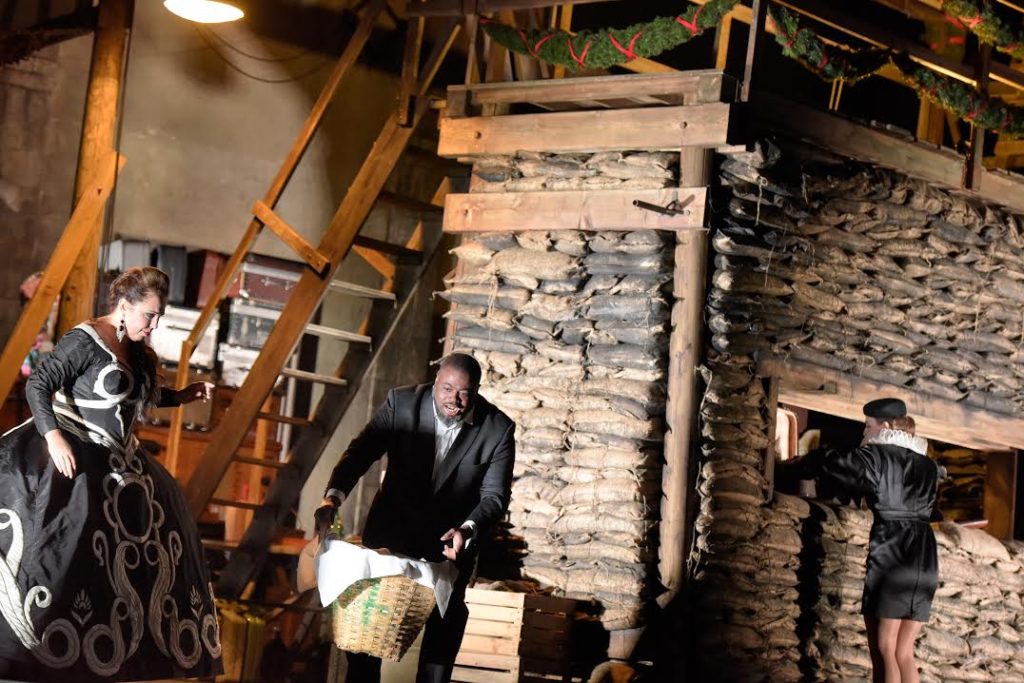
(Credit: Thomas Aurin)
Sounds of a Vengeance
German baritone Markus Brück sang the role of Donna Leonora’s vengeful brother Don Carlo di Vargas. He has a very impressive voice, his use of legato was well-utilised, especially in his “Morir! Tremenda cosa,” which continues with “E questa vitta che debbo al suo valor?” There was no feeling of a volume loss or lack of acoustical support while he engaged in duets with Don Alvaro in the Third and Fourth Act. His second duet with Don Alvaro (“Invano Alvaro ti celasti al mondo..”) was equally impressive from both singers with lots of support from the pit.
Bass-baritone Marko Mimica offered his warm, deep voice for a authoritative account of Padre Guardiano. His scene with Donna Leonora near the end of the Second Act (“Chi mi cerca? Son io”) and subsequent ending scene with a choir (“Il santo nome di dio Signore”) were true examples of solid, resonant voice.
Baritone Misha Kiria really impressed in the role of Fra Melitone. His voice is huge, its potency coming to the fore in “Toh! Toh! Pofare il mondo.”
Mezzo-soprano Agunda Kulaeva sang the role of Preziosilla. Her voice was well-suited for the role, though her diction was not always perfect. She imbued the role with the right dose of joyful emotions on stage, engaging with the chorus in “Al suon del tamburo” in the second Act, and then in the famed “Rataplan” at the end of the Third Act.
Musically, this “La Forza Del Destino” was absolutely impressive, with a top notch cast that maintained profound dramatic expressions at all times, finding their freedom even when limited. Finally, the staging, added texts, video out-takes, and live camera action close-ups were all parts of a huge puzzle that does not have one singular solution.
